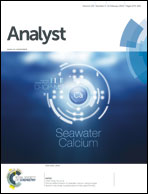Molecular diagnosis of α-thalassemias by the colorimetric nanogold†
Abstract
A new application of gold nanoparticles (AuNPs) as a colorimetric method for gene detection of α-thalassemia 1 (SEA deletion) is reported here for the first time. This technique is based on color changes from salt-induced aggregation of un-hybridized nanogold probes after hybridization with the target DNA. Specific DNA probes were synthesized, thiol modified and conjugated on the surface of AuNPs. The target DNA was amplified and hybridized with the AuNPs-immobilized probe. Salt solution (NaCl) was added to induce aggregation of the un-hybridized nanogold probes. The color changes were visualized either by the naked eye or by UV-vis spectrophotometry at 520 nm. By this nanogold colorimetric method samples carrying normal α-globin genes could be successfully identified from samples carrying α-globin genes causing α-thalassemia 1 (SEA deletion), either as a carrier or disease form. Results demonstrated that the new colorimetric nanogold method is a definite gene diagnosis of α-thalassemia. It is accurate, simple, rapid, specific, sensitive, and cost effective. It is also a promising point-of-care testing (POCT) method for thalassemias and other genetic disorders. The new colorimetric nanogold is a method of choice for areas where access to sophisticated molecular diagnosis is limited.


 Please wait while we load your content...
Please wait while we load your content...